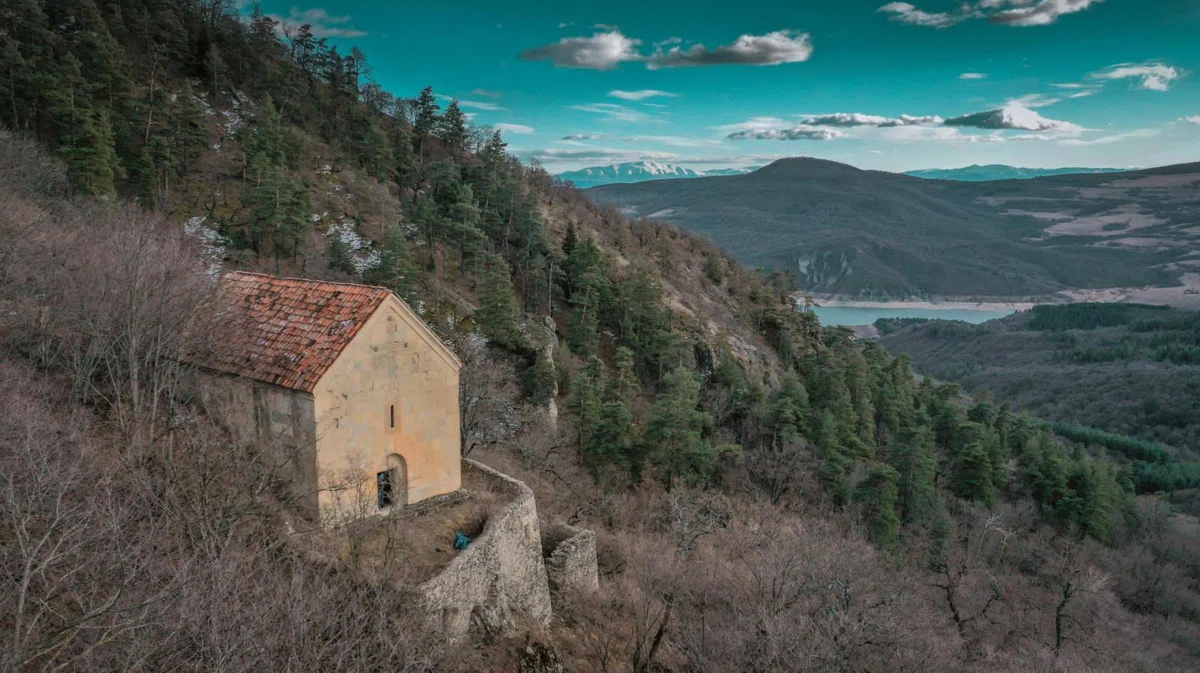
At the edge of modernity: the ancient construction of Amlivi (Amlevi). The location of the complex, its description and history.
Non-tourist destinations and the most inaccessible sights of Georgia. The sacred complex Amlivi is located on the left bank of the Algeti River. To see the ancient structure of the 15-16th century you will have to make a real journey to a height of 1090 meters above sea level!
Let's talk about what you can see in Georgia for lovers of secluded non-tourist places. The sights of Georgia, hidden from the eyes of tourists, will not leave you indifferent, because during such a trip you will not notice where modernity ends and history begins.
The article is devoted to the complex Amlevi - an ancient structure, built in the 15-16th century. Location: region of Kvemo Kartli, municipality Tetritskaro, village Orbeti, the left bank of the Algeti - the largest river of Kvemo Kartli region, at 1090 meters above sea level.
The inscription on the wall of the church, dated 1683, says that Prince Papuna Gostashashvili (one of the branches of the Baratashvili family), during the reign of George XI, built a church, a bell tower, a palace and several agricultural buildings. The interior of the building has not been finished due to the death of the patron; plastering and painting are missing.
The complex is located on the southern slope of the mountain, where the dense deciduous forest ends and the coniferous forest begins. The northern wall of the church is deep in the rock, which gives the overall picture a certain sense of fairy tale. In the western part of the platform you can see a fragment of an ancient church, a hall-type building with a single nave. It is a rectangular oblong structure (12.5x7.5 m), topped with a dome and a semicircular apse. On the sides of the apse is a stone iconostasis (restored), consisting of square columns, on which six arches are located. The entrance to the altar is in the center and to the north of the iconostasis. Behind the apse is a narrow step made of stone. The church has five arched windows, decorated with rich exterior platbands. Three windows are in the south wall, one on the west wall, and one on the east side on the apse. There is a lancet-shaped rectangular niche in the wall of the apse to the north of the last window. On the opposite side, to the south, there is also an irregular-shaped niche deep in the wall. In the chancel is a square table made of monolithic stone. There is a curved cross in the front of the table. The church has two entrances, one to the south and one to the west. There is also a narrow tunnel in the lower left corner inside the church that leads to an underground vault. Under a decorative arch in the west wall on the tympanum is an inscription on the building, protected from outside influences, the corners of the casings are decorated with ornamentation. The southern door has a false lancelike slab, with a single stone tympanum in the middle, on which the outlines of the icon of the Savior have been depicted with modern graphic tools. The floor of the hall and apse is made of stone tiles. The building is topped by a cylindrical vault with three arches. The western arch is supported by pilasters at the junction of the two walls. The paired arches rest on four pilasters in the longitudinal walls. These pilasters are placed on ornamented bases and end with capitals of simple form. The pilasters in the west wall have the same capitals.
The internal supporting structures (triumphal arches with pilasters, arches, door trims, etc.) are made of local natural building material. The walls and roof are built of untreated stone, tufa, and appear to have been prepared for plastering. There is a two-story stone base on the south and west sides of the church. The cornice on the facade is undecorated. E. Takaishvili reported that previously the covering was made of stone slabs, but now, after restoration, it is made of ceramic tiles.
The windows of the eastern facade are decorated with an ornament - a cross-shaped pattern. There are peaks on the cross bars and the upper part of the cross. The same cross, but smaller in size, is located on top of the window on the west side. The lower part of the cross and a fragment of the left crossbar with a peak are preserved to this day. At the bottom of this fragment are painted figures of two small people with their hands raised up. Between them and the hammers on either side is a bowl. It is likely that these figures belong to the builders. The facade of the church is made entirely of tufa. The western facade has a tunnel in the platform that leads to the south and passes through an agricultural structure. There is an entrance to the wall at the north corner of the south wall. Next to the entrance is a two-story bell tower.
Rest assured that the most beautiful places in Georgia are the ones you have yet to see!
------------------------------------------------------------------------
Photo by georgiantravelguide.com













6 comments
Log in to leave a comment